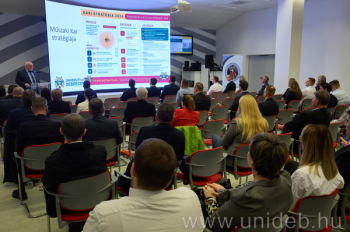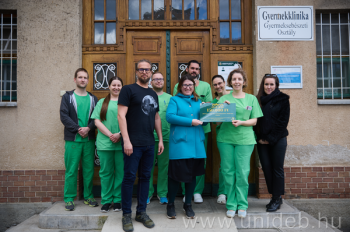This is the first time that the best Hungarian laboratories have been recognized. The ranking was initiated by the National Research, Development and Innovation Office with the aim of identifying the best research facilities in Hungary.
The official certificates attesting excellence were handed over by László Palkovics, Minister for Innovation and Technology, in Pécs.
Out of the research units of UD, the Eastern Hungarian Research Centre for Chemical Analysis and Molecular Structure, the Hungarian Cellular Imaging Euro-BioImaging Node, the Hungarian Medical and Preclinical Imaging Euro-BioImaging Node, the Agricultural and Food Innovation Research Infrastructure of the University and Debrecen, the Proteomics Core Facility of the Department of Biochemistry and Molecular Biology of the Faculty of Medicine of UD, and the Material Science Research Network of the Institute for Nuclear Research have been recognised as Excellent Research Infrastructures. The certificates were received on 16 December by Szilvia Veres, vice dean for scientific affairs of the Faculty of Agricultural and Food Sciences and Environmental Management, György Vámosi, senior research fellow of the Faculty of Medicine, and Ákos Kuki, associate professor of the Faculty of Science and Technology.
Several research units of the Institute for Nuclear Research have also received the “Excellent Research Infrastructure” title.
At the certificate-giving ceremony László Palkovics, Minister for Innovation and Technology highlighted the Catalyst programme of MIT in particular among the international research partnerships.
- Coordinated by the University of Debrecen, the programme completely covers the Central-European region. By now, out of the more than 100 projects 15 have entered into their second phase, which should be considered a success. We have already talked to MIT about the extension of the Catalyst programme, which currently operates only in the field of health science - pointed out Minister Palkovics.
László Palkovics highlighted that one of the most important results of the modification of the research system, which began in 2018, is that the elements designed to support all phases of the process from an idea to a marketable product have been established. He added that the amount allocated to support research and development had doubled in 2021, and will continue growing along with the change of the operational model of the university.
In his speech, István Szabó, vice president for scientific and international affairs of the National Research, Development and Innovation Office said that the title had been designed to recognise the researchers and specialists who operate the tools, rather than the tools themselves.
- The assessment of scientific facilities began in 2008 with the aim to stimulate and inspire the research community. The performance of the research units just recognised has been excellent, even by international standards. Our goal is to make them visible abroad as well, and to make them attractive for young research professionals in Hungary - pointed out the vice president.
The science centres that have received the certificate can use the title “Excellent Research Infrastructure”. These units will appear in the database of the Office, which will greatly improve their visibility both in Hungary and abroad, and may facilitate the establishment of contacts and partnerships in the relevant fields.
Press Office
Fotó: Csortos Csaba/ Pécsi Tudományegyetem


